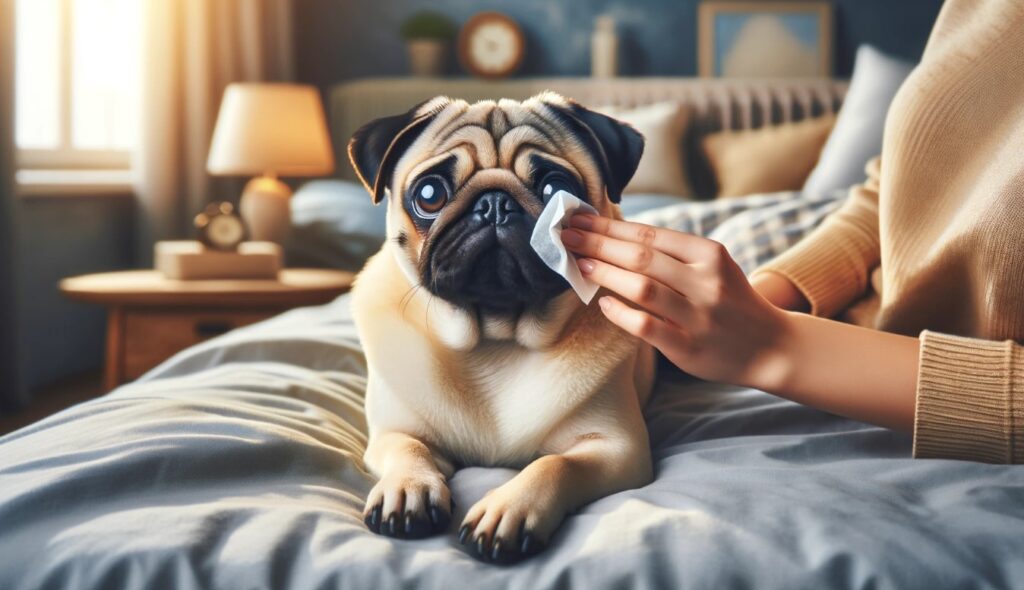Over the years in my practice, I’ve come to appreciate the value of integrating conventional medicine with natural remedies to ensure our furry companions receive the best of both worlds. Our pets, much like us, can sometimes encounter minor health issues that can be managed with a touch of Mother Nature’s wisdom, coupled with our informed care. One such common issue I encounter in many of our four-legged friends is eye infections. It’s heart-wrenching to see our pups with teary, irritated eyes, and while I always advocate for professional veterinary guidance in health matters, I understand the appeal of seeking gentle, natural remedies for initial care or minor cases. This blog aims to offer a guide on how to treat dog eye infections at home with expert-recommended home remedies.
However, it’s imperative to note: while these remedies can be beneficial, they’re not a substitute for professional veterinary care, especially in more severe or persistent cases. Always observe your pet closely and consult with your vet when in doubt. Let’s journey together in ensuring our dogs get the best, most compassionate care they deserve.

Recognizing Signs of a Dog Eye Infection
Our dogs can’t verbally communicate when something is amiss, which makes it crucial for us as pet owners to be keen observers, particularly when it comes to their eyes, which are expressive yet delicate organs. Here are some of the most common symptoms and what they might indicate:
- Redness or Swelling: The whites of a dog’s eyes, also known as the sclera, should ideally be clear. If you notice any redness or swelling, it’s a sign of inflammation. This is often one of the first indications of an infection or another type of eye problem.
- Discharge: A clear, watery discharge is usually a dog’s way of clearing out debris from the eye. However, if the discharge becomes thick, yellow, green, or even white, it could be pus or mucus, indicative of an infection.
- Tearing or Cloudiness: Excessive tearing can be a dog’s response to eye irritation. On the other hand, a cloudy or opaque appearance in the eye might indicate more serious issues like cataracts, corneal problems, or even an internal eye infection.
- Frequent Blinking or Squinting: If your dog is blinking more than usual or seems to be squinting, it could be due to discomfort or pain in the eye. It’s a clear sign that something isn’t right, and their eye or eyes are irritated.
- Scratching or Pawing at the Eye: A dog might scratch or paw at its eyes due to itching or pain. This action can exacerbate the issue and even lead to injuries, so it’s crucial to address the root cause promptly.
By understanding and recognizing these signs early on, we can take steps to ensure they get the care they need, whether through home remedies or a visit to the vet.
Common Causes of Eye Infections in Dogs
Eye infections in dogs are not uncommon, and understanding their root causes can be key to both prevention and effective treatment. Like humans, dogs can develop eye infections from a variety of factors. While some causes might be relatively benign, others can be indicative of more significant underlying issues. Let’s delve into the common culprits:
- Foreign Bodies: One of the most frequent causes of eye infections is the intrusion of foreign objects like dirt, sand, grass, or even an eyelash. These can irritate the eye and introduce bacteria, leading to an infection.
- Bacteria and Viruses: Just as with human eye infections, bacteria (like Staphylococcus or Streptococcus) and viruses can be primary causes. These microbes can enter the eye through various means, including contact with contaminated surfaces, interaction with infected animals, or even via respiratory infections.
- Allergies: Dogs, like humans, can suffer from allergies. Pollen, mold, dust, and certain chemicals can irritate a dog’s eyes, leading to symptoms similar to infections. Over time, chronic allergies can predispose the eye to actual infections.
- Trauma: Injuries to the eye, whether from rough play, encounters with other animals, or accidents, can introduce bacteria into the eye, leading to infections.
- Underlying Health Conditions: Some systemic health problems, like immune disorders or diseases like Canine Distemper, can manifest with eye infection symptoms.
- Tear Duct Issues: Tear ducts play a crucial role in keeping the eyes clean and moist. If they become blocked or don’t function properly, it can lead to dry eyes, which are more susceptible to infections.
It’s worth noting that while any dog can develop an eye infection, some breeds with prominent eyes like Pugs, Shih Tzus, and Bulldogs, or breeds with skin folds, are more prone to certain eye issues.

Expert Home Remedies for Dog Eye Infections
Treating minor eye irritations with natural remedies can be both gentle and effective. However, always remember that these remedies are best suited for mild conditions. If symptoms persist or if you’re unsure about the severity, it’s vital to consult a veterinarian. Here are some expert-recommended home remedies for dog eye infections:
Saline Solution
A saline solution can help cleanse the eye and reduce irritation.
- How to prepare: Mix a teaspoon of salt in a cup of warm, distilled water until dissolved. Allow it to cool to room temperature.
- How to apply: Using a clean cotton ball, gently dab or wipe the dog’s eye, ensuring no direct contact.
Herbal Teas
Herbal teas possess anti-inflammatory and antimicrobial properties, making them a beneficial rinse for irritated eyes.
- Chamomile Tea:
- Green Tea:
- Benefits: Contains antioxidants that can help reduce inflammation.
- Preparation and Application: Similarly, brew, cool, and apply using a clean cotton ball.
Warm Compress
Applying warmth can soothe the eye and alleviate pain.
- How to use: Dip a clean cloth in warm water, wring out excess, and gently place it over the dog’s closed eye for a few minutes.
- Frequency: 2-3 times a day.
Remember, while these remedies can be beneficial for minor irritations, it’s paramount to ensure that the situation doesn’t call for more immediate professional attention. Always prioritize your dog’s well-being, and be cautious when applying any substance near their eyes.

Preventative Measures for Eye Health in Dogs
Maintaining good eye health is not just about addressing infections when they arise but also implementing proactive steps to prevent potential problems. After all, prevention is often the best medicine. Here’s how you can ensure your dog’s eyes stay bright, clear, and healthy:
1. Regular Cleaning
- Why it’s Important: Over time, dust, debris, and discharge can accumulate around your dog’s eyes. This can not only lead to discomfort but also become a breeding ground for bacteria.
- How to Do It: Use a soft, damp cloth or cotton ball to gently wipe away any dirt or discharge from around the eyes. Ensure you use a separate cloth or cotton ball for each eye to prevent cross-contamination.
2. Check Eyes Frequently
- Why it’s Important: Regular checks can help you spot and address any signs of irritation, inflammation, or infection early on.
- What to Look For: Clearness of the eye, any discoloration, swelling, or unusual discharge.
3. Trim Hair Around the Eyes
- Why it’s Important: For breeds with long hair, strands can fall into the eyes causing irritation and potentially leading to infections.
- How to Do It: Using blunt-nosed scissors, carefully trim the hair that falls over the eyes, ensuring not to accidentally poke or hurt your dog. Alternatively, consider taking your dog to a professional groomer.
4. Protect Against External Factors
- Why it’s Important: Various external factors can irritate your dog’s eyes, leading to infections.
- Preventative Steps:
- Outdoor Activities: If your dog enjoys sticking their head out of the car window, consider dog goggles to prevent foreign particles from entering the eyes.
- Environment: Ensure your living environment is free from irritants such as excessive dust or harmful chemicals.
5. Offer a Balanced Diet
- Why it’s Important: Just like humans, certain nutrients can help promote eye health in dogs.
- What to Feed: Foods rich in antioxidants, vitamins, especially Vitamin A, and omega-3 fatty acids can be beneficial. Always consult with a vet for specific dietary recommendations.
6. Be Cautious with Toys
- Why it’s Important: Some toys, if thrown directly towards the face, can accidentally injure the eyes.
- Safety Measures: Opt for size-appropriate toys and be gentle during playtime. Avoid laser pointers, as directly shining them into a dog’s eyes can cause damage.
7. Regular Vet Check-ups
- Why it’s Important: Annual or bi-annual vet visits ensure that any potential eye issues or underlying conditions are spotted and addressed early.
- What to Expect: A comprehensive eye exam will often be part of a regular check-up.
Your dog’s eyes are windows to their soul, and they rely on you for their care. By taking these preventive measures, you can ensure those eyes remain bright and healthy throughout their life.
When to Seek Professional Help
While home remedies and preventative measures are invaluable tools in the arsenal of a responsible pet owner, there are moments when professional intervention is not just beneficial but essential. Our dogs depend on us to discern when their condition warrants more than home care. Here’s how to know when it’s time to see a veterinarian:
1. Persistence of Symptoms
- Concern: If after trying home remedies for a couple of days you notice no improvement, or if the symptoms worsen, it’s a clear signal to seek professional guidance.
- Why: Persistent symptoms can indicate a more severe underlying condition or an infection resistant to simple treatments.
2. Change in Eye Color or Appearance
- Concern: Any cloudiness, discoloration, or opacity in the eye can be indicative of serious issues such as cataracts, glaucoma, or even an internal infection.
- Why: These conditions can compromise your dog’s vision or lead to more complex health challenges if not addressed promptly.
3. Behavioral Changes
- Concern: If your dog becomes more withdrawn, avoids light, becomes aggressive when you approach their face, or seems to bump into objects more frequently, it could be a sign of diminished vision or eye pain.
- Why: Behavioral changes often indicate discomfort or potential loss of vision, necessitating immediate attention.
4. Excessive Discharge or Pus
- Concern: Thick, yellow, green, or bloody discharge is typically a sign of a bacterial or viral infection.
- Why: Such infections can escalate quickly, causing further complications or damage to the eye.

5. Swelling or Bulging Eyes
- Concern: If one or both eyes appear swollen or seem to bulge, it can be a sign of glaucoma, tumors, or other significant issues.
- Why: Conditions like glaucoma can escalate rapidly and lead to blindness if not treated in time.
6. Visible Injuries
- Concern: Any scratches, cuts, or puncture wounds around or on the eye require immediate attention.
- Why: Injuries can introduce bacteria, risking infection, or cause direct trauma to the eye which might impact vision.
7. Frequent Scratching or Pawing
- Concern: If your dog continuously scratches or paws at its eyes, even after initial cleaning or home treatment, it’s a sign of ongoing discomfort.
- Why: Continued scratching can exacerbate the issue, potentially leading to injuries or aggravating the infection.
8. Recurrence of Issues
- Concern: If your dog seems to suffer from repeated eye infections or irritations, it’s essential to consult with a veterinarian to understand the root cause.
- Why: Recurrent issues can signify an underlying health condition, allergy, or environmental irritant that needs addressing.
In essence, while home remedies are an excellent first line of defense and care, they are not a replacement for professional veterinary expertise. Always err on the side of caution, prioritizing your dog’s wellbeing above all else. When in doubt, pick up the phone and consult your vet. They’re there to help ensure your furry companion leads a healthy, happy life.

Conclusion
Our furry companions rely on us to navigate the world of their health and well-being. Their eyes, shimmering windows to their boundless souls, are not just essential for sight but are indicators of their overall health. While understanding the nuances of common eye infections, recognizing symptoms, and trying expert-approved home remedies can offer solace in times of minor ailments, it’s paramount to recognize the limits of home care. The bond between you and your canine friend is priceless, and as guardians of their health, it’s our duty to strike the right balance between holistic home treatments and timely professional interventions. Remember, a proactive approach, combined with a keen observance of their behavior, will ensure those loving eyes continue to gaze at you with clarity and affection for years to come. After all, in the journey of companionship, our ultimate goal is their happiness and well-being.
Frequently Asked Questions
While some human products might be safe for dogs, many aren’t. Always consult with a veterinarian before applying any human medication to your dog’s eyes to ensure safety and appropriateness.
Simple irritations often present as temporary redness or minor discharge and might resolve on their own or with gentle cleaning. However, persistent redness, cloudiness, excessive discharge, swelling, or behavioral changes indicate a more severe infection or issue.
It’s advisable to try one remedy at a time. This way, you can monitor your dog’s reaction and ensure they don’t have an adverse response. Combining remedies can also make it challenging to identify which one is effective or causing potential irritation.
Regular cleaning can be beneficial, especially for breeds prone to eye issues. Gently cleaning the area around the eyes once a week, or whenever you notice dirt or discharge, can help prevent infections.
Recurrence depends on the cause. If it was due to an external factor like a foreign object, chances might be lower. However, if it’s because of underlying health issues or environmental factors, there could be a higher risk. Ensure you follow all preventive measures and consult with a vet about any concerns.
